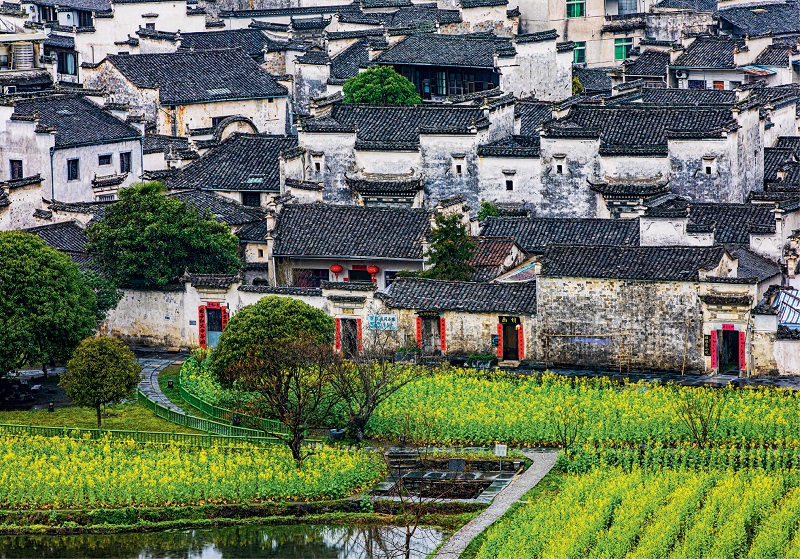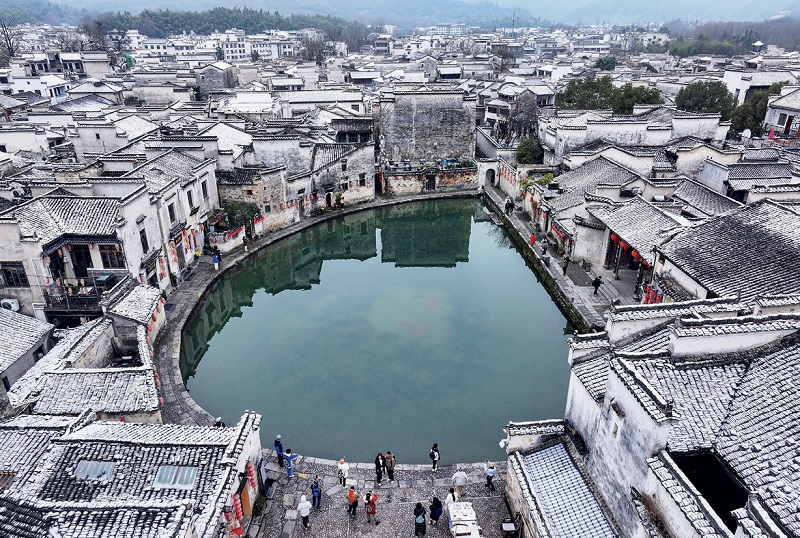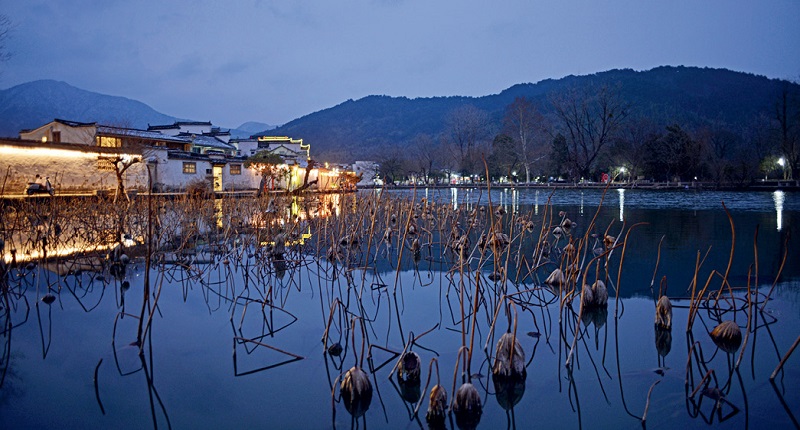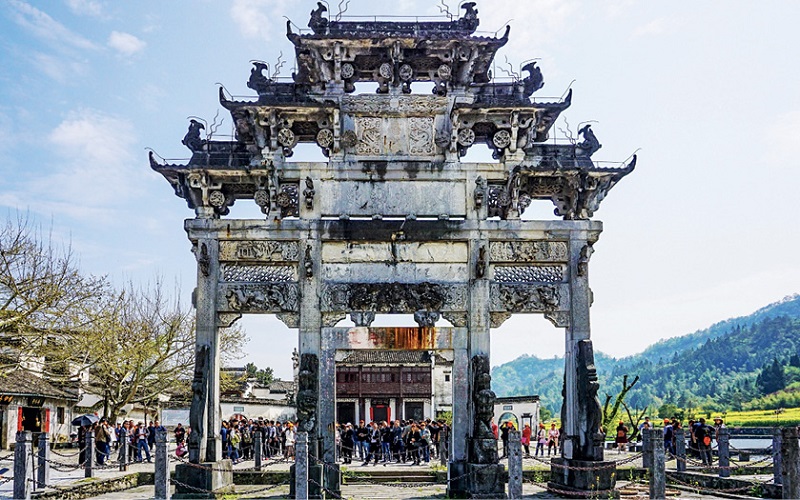
Life slowly begins to wake up during an early-spring morning in Xidi Village on March 19, 2023.
Southern Anhui Province, which was known as part of Huizhou in the past, boasts a rich historical and cultural legacy. During the Ming (1368-1644) and Qing (1644-1911) dynasties, Huizhou (Hui) merchants, accumulated large wealth thanks to the region’s thriving economy. Meanwhile, this merchant group created a distinct cultural and aesthetic style. Xidi Village and Hongcun Village in Yixian County, Huangshan City of Anhui Province, are home to many Hui merchant families. These two villages are renowned for their idyllic scenery, well-preserved village landscapes, and elaborately built Hui-style residential dwellings. In 1999, UNESCO inscribed these two ancient villages into the Word Heritage List.
Nestled in the arms of surrounding mountains, the boat-shaped village of Xidi measures around 700 meters from east to west and 300 meters from north to south. It has a population of over 1,000 from more than 399 households. With a history of over 960 years, Xidi emerged in the Song Dynasty (960-1279), developed quickly during the Ming Dynasty, and peaked in the early Qing Dynasty.
Xidi was the home of a Hu clan. Here, each street was built beside a canal diverted from two rivers flowing through the village. More than 90 paths lined with high walls present a delightful fluidity of spatial layout. Today, over 300 residential houses of the Ming and Qing dynasties still stand in Xidi, and over 100 are well preserved. These buildings demonstrate the exquisite architectural artistry of ancient Huizhou, show off a unique humanistic legacy and reflect distinct regional characteristics.
As a symbol of welcome, a distinguished archway stands at the entrance of the village. It was constructed in 1578 on imperial order. This monumental structure was dedicated to Hu Wenguang, a high-ranking official from Xidi, for his 23 years of dedicated political career. The imposing and skillfully crafted archway is around 12.3 meters high and 10 meters wide, and is made of a high-quality stone.

An aerial view of a snow-covered Hongcun Village.2023.
Huizhou residential buildings are characterized by black tiles, white walls, halls, and courtyards. From the outside to the inside and from the floor to the roof, carved stone, brick, and wood can be found everywhere in each house, all of which are of high artistic value. Residential complexes including Dongyuan, Dunrentang, and Jing’aitang are open to the public.
Dong Garden is a three-courtyard complex, composed of a study hall, a main hall and a front hall. The main hall was used to receive distinguished guests, while the front hall received relatives and friends. The study hall served as a study as well as a venue for old-style private schooling. Xidi’s residential complex usually has an open-air square yard enclosed by buildings from four sides. Water was believed to be a symbol of fortune, so, in Xidi, the open yard captures rain water that flows down from slanted roofs, indicating the gathering of wealth. Another sign of the belief in water is that all gates of Xidi houses face the creek flowing through the village.
Dunrentang was the residence of Hu Guansan, a prominent Hui merchant. It was built during the Qing Dynasty, covering an area of 174 square meters. The imposing central hall is characterized by large rooms and sufficient natural light. There is a large courtyard in front of it, commonly known as the “mother” courtyard; the two side rooms also had a small courtyard similar to a skylight, commonly known as the “child” courtyard. This is a unique and rare layout among the ancient houses in Xidi.
Meanwhile, Jing’aitang was a clan hall to honor ancestors. This four-century-old complex covers an area of 1,800 square meters. Its name Jingai (tang means house or hall in Chinese) means respect and love in Chinese to inspire respect and love among siblings and clan members, as well as care for elderly people and children. This venue was used to discuss major affairs concerning the clan, to host weddings and other celebratory events, and to discipline recalcitrant members.
A number of couplets can be seen in Xidi dwellings, conveying notions like forming the habit of learning, having good manners, as well as being humble, sympathetic, and forgiving. These principles embody the recognizable Hui merchant spirit including exercising kind deeds, valuing education, and being righteous and sympathetic, which were conducive to their robust nationwide business.

Two workers are installing a bucket arch on a Hui-style historical building.
Hongcun Village
Sitting at the foot of the Huangshan Mountain range, the origin of Hongcun can be traced back to the Southern Song Dynasty (1127-1279), originally the home of a Wang clan. Hongcun residents planned and constructed a creative bull-shaped village, which has an operating man-made water system. The towering Leigang Hill is the head of a bull, ancient trees are the horns, the residential blocks stretching from east to west are the huge bull’s body, the Yinqing Spring is the bull’s intestines, the Yuezhao Pond is known as the stomach of the bull, and the Nanhu Lake is known as another stomach. In this notable layout, each household has access to flowing water in front of their house.
The village’s Yuezhao Pond was built during the early Ming Dynasty. A villager named Wang Siqi found a natural spring flowing all-year-round within the village, so he invited professionals to formulate plans for diverting the spring water to a man-made pond, for the purpose of fire fighting, accessing drinking water, washing, and other purposes. The pond was later built into a half-moon shape, and its water is clear and calm.
By the late Ming Dynasty, the water storage of the Yuezhao Pond was no longer capable of meeting the need of the growing population in the village. The village therefore converted a patch of cropland into a lake, which was built to resemble the well-known scenic West Lake. A stone bridge traverses the lake, facilitating transportation.
There are more than 140 well-preserved quaint houses of Ming and Qing Dynasties in Hongcun. Chengzhitang, in particular, is one of the most well-preserved buildings in Yixian County. Spanning an area of more than 2,000 square meters, this magnificent wood-and-brick structure complex used to be the residence of a salt merchant in the Qing Dynasty. The layered wood carvings on the beams, arches, doors, and window frames of the main hall exquisitely portray numerous opera or legendary characters, and are considered a masterpiece of Hui-style carving art.
Another historic dwelling, Shurentang, which was built during the late Qing Dynasty, was the residence of officials at that time. Today, it is a private folk art museum run by the owner of the complex. To let more people know about Huizhou’s history and culture, the owner has gathered a collection of old workshop instruments, stone utensils, Huizhou wood paintings, Huizhou merchants’ correspondence tools, Hongcun genealogy, and other folk items, providing a glimpse into the daily life of Huizhou hundreds of years ago.

The outline of the illuminated Hongcun Village is clearly defined against the evening sky.
Modern Utilization
Yixian County has also developed a band of leisure and tourism projects, such as flower viewing, cycling, photography, B&B services, research trips, weddings, and night tours. Renowned for its picturesque and idyllic landscapes as well as quaint buildings, Yixian has become a magnet for art students who are looking for an ideal place for painting village life. Yixian has therefore taken this opportunity to develop supporting services catering to this group including accommodation, catering, and training courses, which has become an effective way for the sustainable development of the world cultural heritage site.
In recent years, Yixian has allocated 20 percent of the scenic spot ticket revenue as special funds for cultural relic protection, amounting to approximately RMB 15 million. It also involved some skilled Hui-style architecture lovers to develop the tourism industry as well as improve cultural heritage protection and utilization. In restoring historic buildings, construction workers try to retain their original layout and components to maintain original appearances, and most of the restorations are therefor done by hand.
The high-speed railway connecting Yixian County has greatly shortened the travel time from and to Shanghai, Wuhan, Hangzhou, and other major cities, drawing streams of visitors to savor the traditional culture of Huizhou.

The distinguished archway dedicated to Hu Wenguang dating back to the Ming Dynasty is one of Xidi’s most iconic landmarks.
